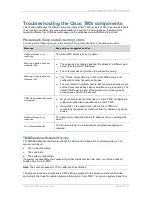
Adding systems
Cisco TMS Administration Guide
Page 12 of 37
How pre-registration works
When pre-registering a system, you can select whether you want the system to be identified on MAC
Address, IP/Hostname or Serial Number.
Note that only the Cisco TelePresence System MXP series and Polycom HDX endpoints can pre-
register based on serial number. Also keep in mind that only systems supporting SNMP can be pre-
registered by serial number and MAC-address if they are using static IP addresses. Cisco
TelePresence System MXP endpoints are using HTTP traps rather than SNMP traps to communicate
with the Cisco TMS server for most information. They are therefore dependent on having their
External Manager’s IP address configured. This is done automatically when the endpoint contacts the
DHCP server to retrieve an IP address, but only if the option 242 on the DHCP server is configured to
point to the Cisco TMS server.
Configuring the DHCP server
If you are using a Windows 2000/2003 DHCP server, add the following settings in the
DHCP Manager
You can create the 242 option by redefining an existing global option. To do this, highlight the global
option in the “Unused” list and click Add in the DHCP manager. Once you have defined a vendor-
specific option, you can select it for use by the vendor class by moving the option to the “Configured”
list, and defining its value which should be the IP or the DNS name of the Cisco TMS server.
If you are using ISC’s DHCP-server, put the following statements in dhcpd.conf.
1. Define option 242:
option local-tms-ip code 242 = ip-address;
2. Define the value in the subnet of pool section:
option local-tms-ip < IP address>;
If the systems are not using DHCP, they need to be able to respond to the SNMP broadcast
messages that Cisco TMS will send out on set intervals. This interval is configurable in
Administrative Tools > Configuration > Network Settings > TMS Services >SNMP Broadcast
Interval (in minutes).
Note: The Cisco 150 MXP with L1.1 and L1.2 is configured to request the DHCP for option 173. It is
therefore advised to either upgrade the endpoints to newer software, or to configure both the option
242 and 173 on the DHCP server until the endpoints are upgraded.
Persistent settings
Persistent settings allow the administrator to enforce settings on systems throughout the network.
These persistent settings can be specified during pre-registration or after the system has been added
to Cisco TMS (via the Persistent settings tab in Navigator).
The persistent settings will be set on the endpoint every time Cisco TMS receives a boot event from
the endpoint; either via SNMP or HTTP. The Persistent setting template is also set on the system at
the same time every day. This time is based on the first time the template was set on the system and
is configurable when editing the template in the Systems > Provisioning > Configuration
Templates page.
To view a log of the daily updates go to Systems > Provisioning Activity Status. You will see that
there are 2 types of entries; the first will be when the template has been set on the system and this will
have no recurrence set. As the second entry you will see the template again but the recurrence will be
set to every day. If you click on this description, you will see a log of all transactions for this template.
There are four persistent settings, and three of them allow you to set a persistent System Name,
H323 Id, E164 Alias and SIP URI. The last setting gives you the option to pick a predefined template
that will be set on the endpoint after every system boot. The template can typically include settings like
Auto answer on, Microphone off and Volume 7.













































